HUAY NAM RIN, THAILAND - The morning sun glows red through the trees. The mountains they call the Golden Triangle — where the borders of Thailand, Myanmar and Laos meet — frame the scene from our balcony in the northern Thai city of Chiang Mai. A barefoot saffron-clad monk carries his offering bowl (tak bat) back to his temple as incense drifts through the air.
A new day begins and we’re excited about our plan to visit a nearby tribal city where indigenous people — Lahu, Akha, Hmong, Yao, Karen and Lisu — have lived and thrived in the mountains using their own language, customs and distinct way of dressing.
A big black SUV pulls up in the parking lot and Mimi jumps out and greets me with “Good morning Auntie!”
Dark-eyed Mimi was four years old when we first met — a tiny thing standing on a dirt path in the mountain village where she was born. I recognized her dress that day — it had been a favourite of my own daughter’s, after all — as I had been sending clothes to her people, the Lisu, in care of an anthropologist friend living in the village.
All grown up now, Mimi fondly calls me Auntie as is custom in the East.
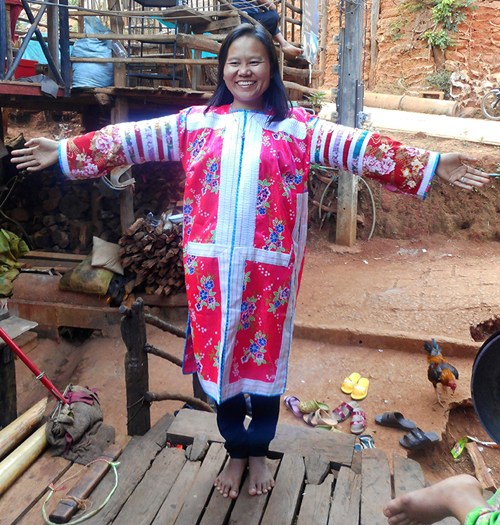
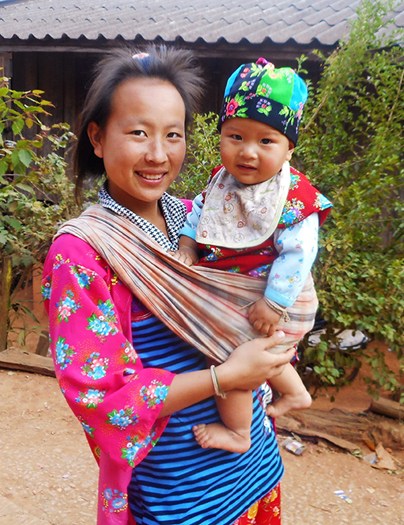
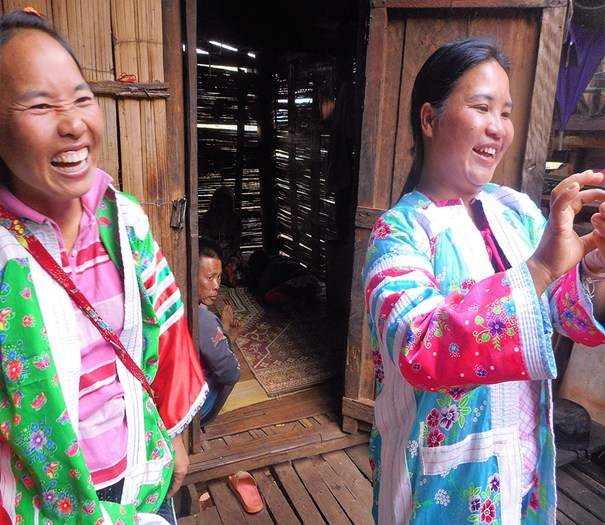
Left: Mimi shows off a new garment. Centre: Proud mother and child. Right: Local women share a laugh.
At the helm of our rental van sits Mimi’s boyfriend, Joe, visiting from Myanmar. With his shoulder-length hair and easy manner, Joe makes the perfect driver. His musical selections for our day trip are Top 40 hits from the 1970s and ’80s.
Mimi and Joe have been celebrating the Lunar New Year in her home village; dancing, mingling and imbibing quantities of homemade corn liquor. Their partying has taken its toll, so we’re late leaving Chiang Mai — but hey, mai pen rai (don’t worry), as they say in these parts.
After a two-hour climb along smooth, curving Highway 120 northward toward Chiang Rai, Joe pulls into a spanking new plaza to gas up so we take the opportunity to get a coffee. Joe, who runs a construction company in Yangon, tells us he was arrested with a dozen political friends and he spent two years in prison. He assures us it wasn’t too bad; he wasn’t tortured.
Cappuccino in hand, I gaze around, pondering the changes I’ve seen since my first visit here three decades back. Back then, a hired Jeep dropped my anthropologist friend and I at a gathering point, where we chatted with tribes people and European trekkers, until a truck took us up the steep dirt road to Doi Laan (See-the-Tiger) village.
In a region once famed for its opium — a cash crop eventually banned by the Thai government — efforts at growing replacement crops, like tomatoes, were having mixed results. In the village, I lodged with my friend in her thatched bamboo hut, sipped Nescafé by a smoky wood fire, shared meals with Mimi’s grandparents and was dazzled by mountain vistas by day and starry canopies by night. Before sleeping, I sealed my contact lenses in a “baggie” pegged on a clothesline so the rats wouldn’t get them.
Time, as always, has brought changes. The smiling young woman that greets us this morning is no longer a shy village girl. Mimi speaks fluent English (plus Thai and Lisu), holds a Master’s degree in Ethnic Minority Studies from Chiang Mai University, and has launched a Lisu Cultural Centre in the city — a showcase for tribal crafts, jewellery and history — where she also organizes afternoon English classes for migrant children.
Huay Nam Rin (Slowly Running Steam), the village we’re visiting today, welcomes Westerners, boasts a few small restaurants, a sundry shop and home stay accommodations, all without being touristy, or worse, exploitive. Some chatty Italians are just departing when we arrive, a reminder that Westerners have roamed these hills for generations.
Ducking through the doorway of the wooden home belonging to Sombat, a Lahu village elder, we relax while lunch is prepared. Joe finds a handy mattress and promptly falls asleep.
Aromas of wood smoke combine with the mountain air and quickly make us forget about city life. Shafts of sunlight illuminate the simple room, where we sit in a circle, sipping glasses of Chang beer. Beneath the floor, pigs snort and outside chickens strut, roosters crow, dogs laze in the sun and children play with hand-carved wooden slingshots.
Casual commerce also takes place. When I admire some woven shoulder bags, Sombat reaches for a selection hanging on a wooden pole and I buy two pieces. Later, we purchase a litre of gold mountain honey — among the world’s best.
It’s a peaceful scene here but in the 1920s, when nomadic tribes from Myanmar, Tibet, and China began to settle permanently in these hills, they endured hostility and lived in poverty.
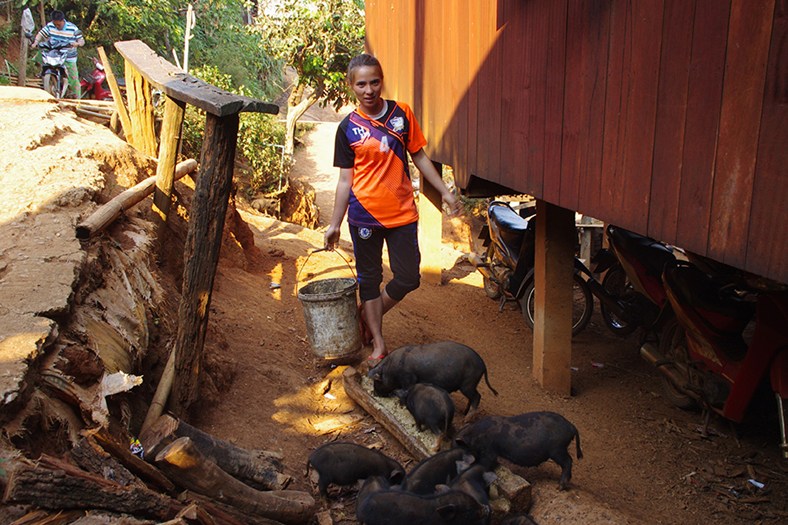
Right: Women do most of the manual labour in Thailand's rural villages.
Lahu means “hunters,” but these former nomads have long lived as subsistence farmers, like most hill tribes. And new crops — especially coffee — are meeting with success. One young Akha entrepreneur markets his people’s organic Arabica coffee beans to outlets in Canada and the United States (look for Doi Chaang coffee at your local Sobey’s). With input from a variety of projects championed by the Thai royal family, other crops, like tea and strawberries, have also become popular, along with new agricultural methods — and traditional arts and crafts. As for opium, it’s still here — in a museum in the town of Chiang Rai.
After lunch — rice, veggies, curries, salads and a gorgeous coriander-infused chili sauce — we gather for group photos. Smart phones and iPads appear; Mimi and her friends don bright Lahu robes and we all — including Auntie Nancy — pose happily in the sunshine.
As the women’s talk turns to local issues, we’re enticed by a brick-red road twisting and turning through the quiet village. We hike for an hour, passing a proud villager’s shiny new motorbike, a smiling mother holding her baby and airy hillside houses perched on stilts. Even laundry drying in the sun looks exotic to us.
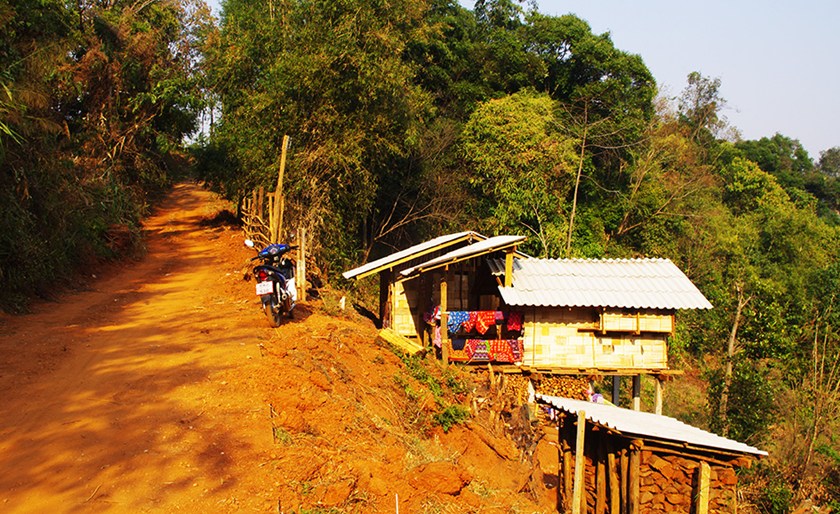
Above: The small villages of Thailand are mostly poor but no one goes hungry here.
At the crest of the highest hill, we happen on a Royal Agricultural Research Station where two smiling Thai women sit behind desks. Nothing much is happening — perhaps because of the Lunar New Year holiday.
Few villagers have fared as well as our Mimi. Educated at a Buddhist-run residential school, she saw her parents just once a year until she graduated. Mimi’s youngest brother recently graduated with a degree in tourism development from Chiang Rai University and the siblings plan to open their own home stay in the village where they were born.
Now I have another reason to return.
Information
To visit a hill tribe village, contact Tourism Thailand - www.tourismthailand.org Their new guide to Royal Projects is full of interesting suggestions, including home stays. / For Huay Nay Rin, contact Jaffa Jahu (090-958-2903). / No time for a mountain trip? Visit Mimi’s Lisu Culture and Heritage Center (80, Bamrungrat, soi 2, near Wat Ket), Chiang Mai. FB: LisuPatchwork-LisuCulturalHeritageCenter: lisumolazu@gmail.com / The best way to get to Thailand from Canada is with Air Canada or Cathay Pacific airlines via Hong Kong. / Tour East Holidays offers many tour packages to Thailand. For information, please go to www.toureast.com